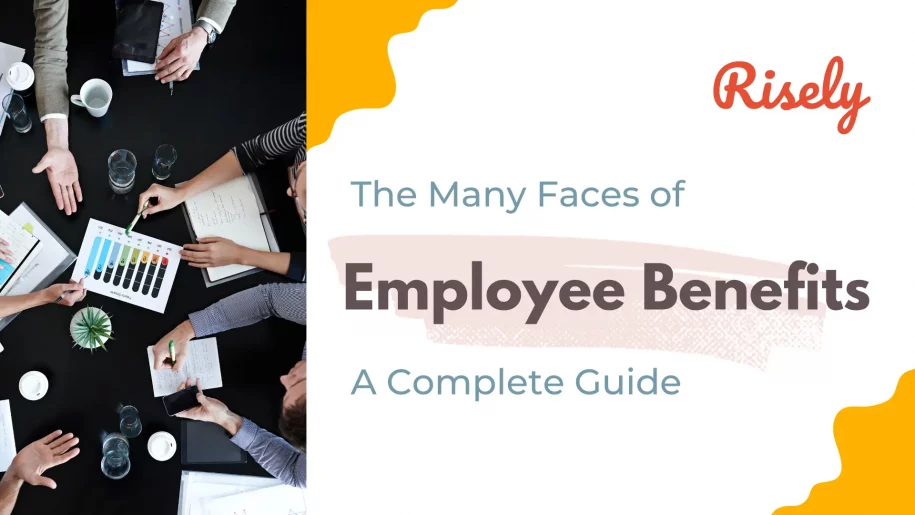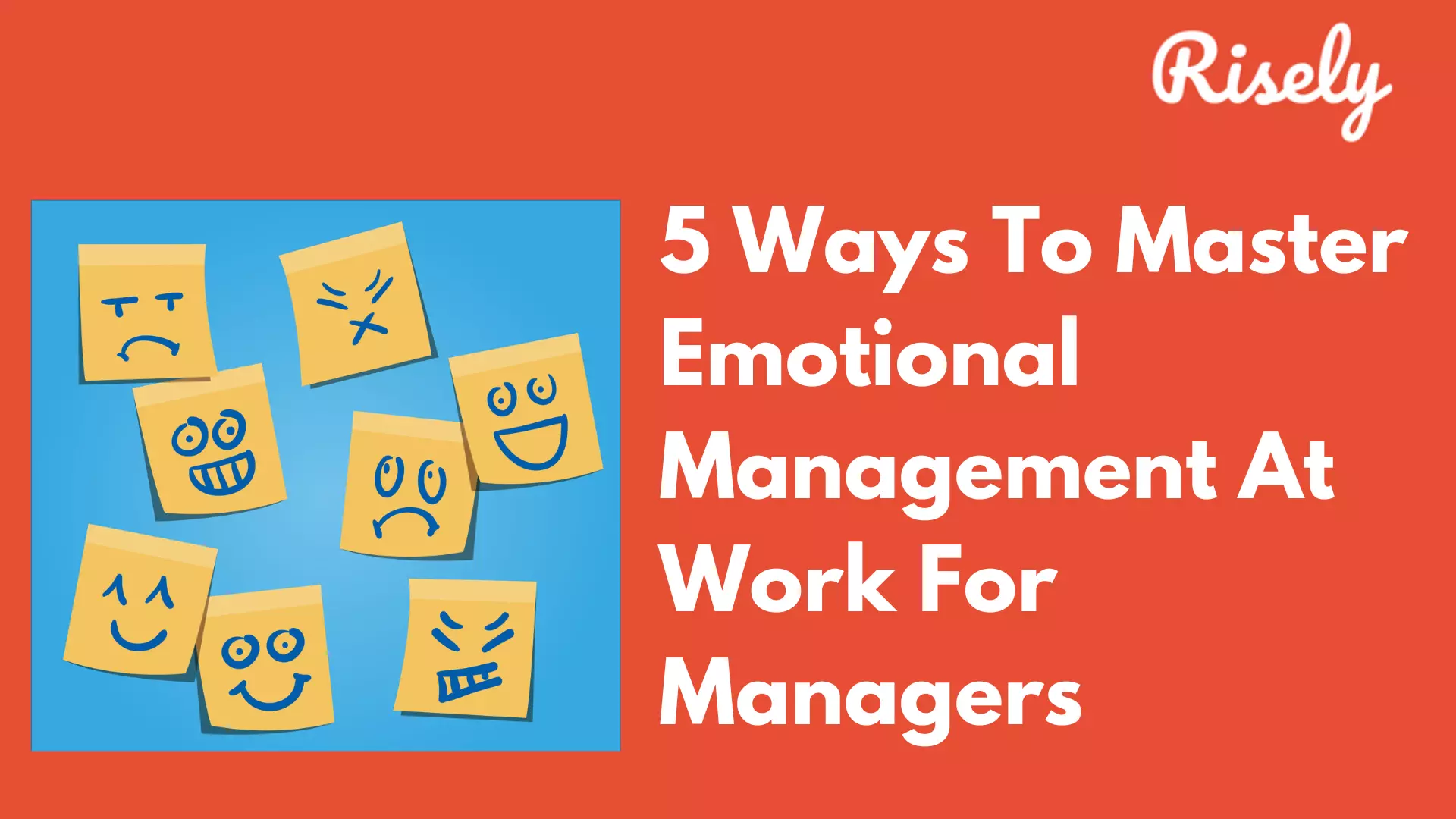The Many Faces of Employee Benefits: A Complete Guide
As an organization, taking care of your employees is crucial. One way to do that is by offering them employee benefits. However, employee benefits can be complex and confusing to navigate. The list seems endless, from healthcare plans and retirement savings to paid time off and additional compensation. But fret not; this complete guide on the many faces of employee benefits will help you understand what they are and how they can benefit your organization. In this blog post, we will cover everything from understanding the importance of employee benefits for an organization to critical factors to consider while creating a mix of uses. We will also delve into different types of employee benefits and how you can leverage them for organizational success. Lastly, we will provide tips on creating an effective employee benefits plan while busting some common misconceptions about them. So read on to discover how you can simultaneously care for your employees and organization!What are Employee Benefits?
Employee benefits are a crucial factor in attracting and retaining top talent. By offering a comprehensive benefits package, companies can improve job satisfaction and boost employee morale. These benefits guide decisions about health, retirement, and financial well-being. Key components of employee benefits include access to health insurance and life insurance, which contribute to the overall well-being of employees. Additionally, retirement plans offer employees the opportunity to save for their future. Organizations need to understand the significance of employee benefits and their impact on critical areas like employee satisfaction and retention to align them strategically with their goals. There’s no doubt that benefits matter to employees. But what are the correct picks? According to SHRM’s 2023 Employee Benefits Survey, health-related benefits top the chart. Such shifts in the perceived value of specific benefits are often a tale of our time. In addition to the post-pandemic atmosphere, Gen-Z and Millenials’ entry has also shuffled things up, with significant emphasis on flexible options, as outlined by Forbes’ Workplace Benefits Trends by Generation.Why Employee Benefits Matter to an Organization?
- Employee benefits are vital to job satisfaction, impacting employee retention and attracting top talent. A great mix of benefits helps organizations retain talent longer through a great employer brand.
- A competitive benefits package sets organizations apart, highlighting their commitment to employee well-being. It is essential to brand the employer as a fair and empathetic party.
- Employee benefits contribute to financial security, reducing stress and increasing productivity. A package that combines non-financial benefits like insurance, food coupons, or flexible hours can help improve the quality of life for employees.
- Effective management of benefit plans can even lead to cost savings for the organization. On the other hand, organizing employee benefits effectively helps employees save on expenses and taxes.
- Employees feel supported and valued by health insurance, retirement benefits, and other perks, fostering a positive work environment.
Other Interesting Reads
Key Factors to Consider in Creating a Mix of Benefits
- Employee Demographics: When designing a benefits package, it is essential to consider the workforce’s diverse needs. Employee demographics play a significant role in determining the right mix of benefits. For instance, a parent values paternity leave; meanwhile, someone with precarious health will appreciate good health insurance. On the other hand, a student working part-time would love flexible work hours. Your employee benefits program should cover the varied needs of the team members to ensure a fulfilled work experience.
- Team’s Values: Aligning the benefits package with the company values and culture creates a positive and supportive work environment. Suppose you are a remote-first workspace that relies heavily on individual ownership. Your benefits package should reflect that through programs designed to cater to the needs of working remotely, such as discount coupons and allowances for an internet connection. Similarly, a team that emphasizes learning can incorporate learning budgets for their members.
- Budget: Budget constraints should be considered to ensure the benefits program’s sustainability. Offering a variety of benefits, such as health insurance, retirement plans, and paid time off, provides employees with options that suit their individual needs. But at the same time, you can keep your budget manageable. Hence, adding non-financial incentives through partnerships and group discounts for your organization is best.
- Industry: Regular evaluation and adjustment of the benefits mix based on employee feedback and changing industry trends is crucial for ensuring the program’s effectiveness. Ensure your employees are paid adequately for their efforts and skills, in tune with the larger market trend.
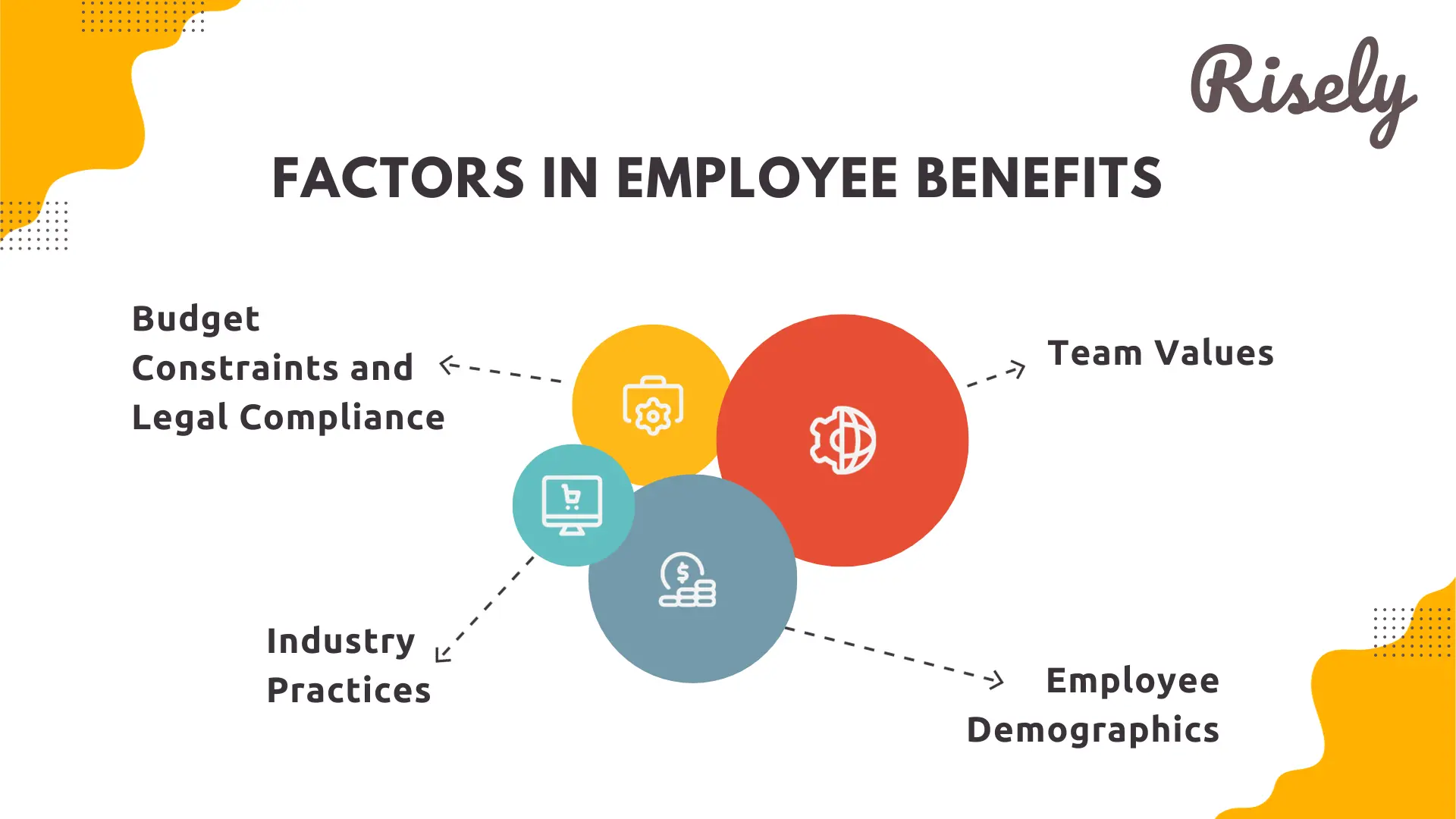
Types of Employee Benefits
Insurance and Healthcare Benefits
Health, dental, vision, life, and disability insurance are essential components of employee benefits. Health insurance covers medical expenses, ensuring employees have access to necessary healthcare. Dental insurance plans help cover the cost of dental care, promoting overall oral health. Vision insurance plans assist with the cost of eye exams and prescription eyewear. Life insurance offers financial protection for employees and their families in the event of death. Disability insurance provides income replacement if an employee cannot work due to illness or injury. These insurance benefits are crucial in providing employees with the necessary support and protection for their physical and financial well-being. Other healthcare benefits can include partnerships with enabling organizations to provide in-house facilities like counseling, wellness sessions, gym memberships, etc.Retirement Plans
Retirement plans are crucial in securing employees’ financial future beyond their working years. One popular option in the United States is the 401(k) plan, which allows employees to contribute a portion of their salary towards retirement savings, often with employer-matching contributions. Similar programs exist in India as provident fund schemes for government employees. Another type of retirement plan is the pension plan, which provides a defined benefit based on years of service and salary history. Additionally, individual retirement accounts allow individuals to save for retirement independently. Offering these retirement plans demonstrates an organization’s commitment to long-term employee well-being and helps employees build a solid financial foundation for their future.Paid Time Off and Family-friendly Plans
Paid time off is an essential aspect of employee benefits, providing various opportunities for employees to take a break from work. Vacation days allow employees to recharge, pursue personal interests, and maintain a healthy work-life balance. Sick leave ensures that employees are cared for when they are ill or need to look after a sick family member. Parental leave allows new parents to bond with their children and adjust to their new family dynamic. Organizations are also incorporating mental health leaves in their benefits to enable the mental wellness of their employees. Additionally, holidays and bereavement leave provide employees the necessary time to celebrate important occasions and grieve the loss of loved ones. Offering paid time off supports employees’ well-being and helps prevent burnout. It enables a healthy employee-employer relationship based on empathy and understanding.Additional Compensation and Rewards
Competitive salary packages play a crucial role in attracting top talent. Stock options offer employees an opportunity for financial growth and provide a sense of ownership in the company’s success. Profit-sharing plans serve as a means to reward employees for their valuable contributions to the organization’s success. Retirement plans ensure employees’ financial security in the future, allowing them to plan for a comfortable retirement. These additional compensation elements are essential in creating a comprehensive and attractive employee benefits package.Employee Assistance Programs
Employee Assistance Programs are designed to help employees facing personal and professional challenges that impede their growth. It can be helpful at many stages, such as personal crises, acute performance issues, or job changes. EAPs typically include services such as guidance & counseling, assessments, and follow-up support to help with rehabilitation.Growth and Development Opportunities
Investing in employees’ growth through educational and training opportunities enables employers to act as a catalyst for their growth. Employee benefits that impact growth can take up many forms, such as learning budgets for teams and individuals, partnerships with educational providers, and reimbursements of fees through more accessible funding opportunities. All in all, growth and development opportunities help employers create a more dedicated and upskilled workforce. Read more: Why Training and Development is Important for Teams?Quality of Life Benefits
Some employee benefits do not fall into simple categories, but adding them to the mix makes the employee’s life easier and, thus, enables them to be more productive at work. This section can specifically include features such as access to legal and financial advisory services. Commuter benefits help alleviate transportation costs, making the daily commute easier for employees. Perks like free snacks, gym access, on-site cafeterias, and discounts on products and services can be other ways of doing this.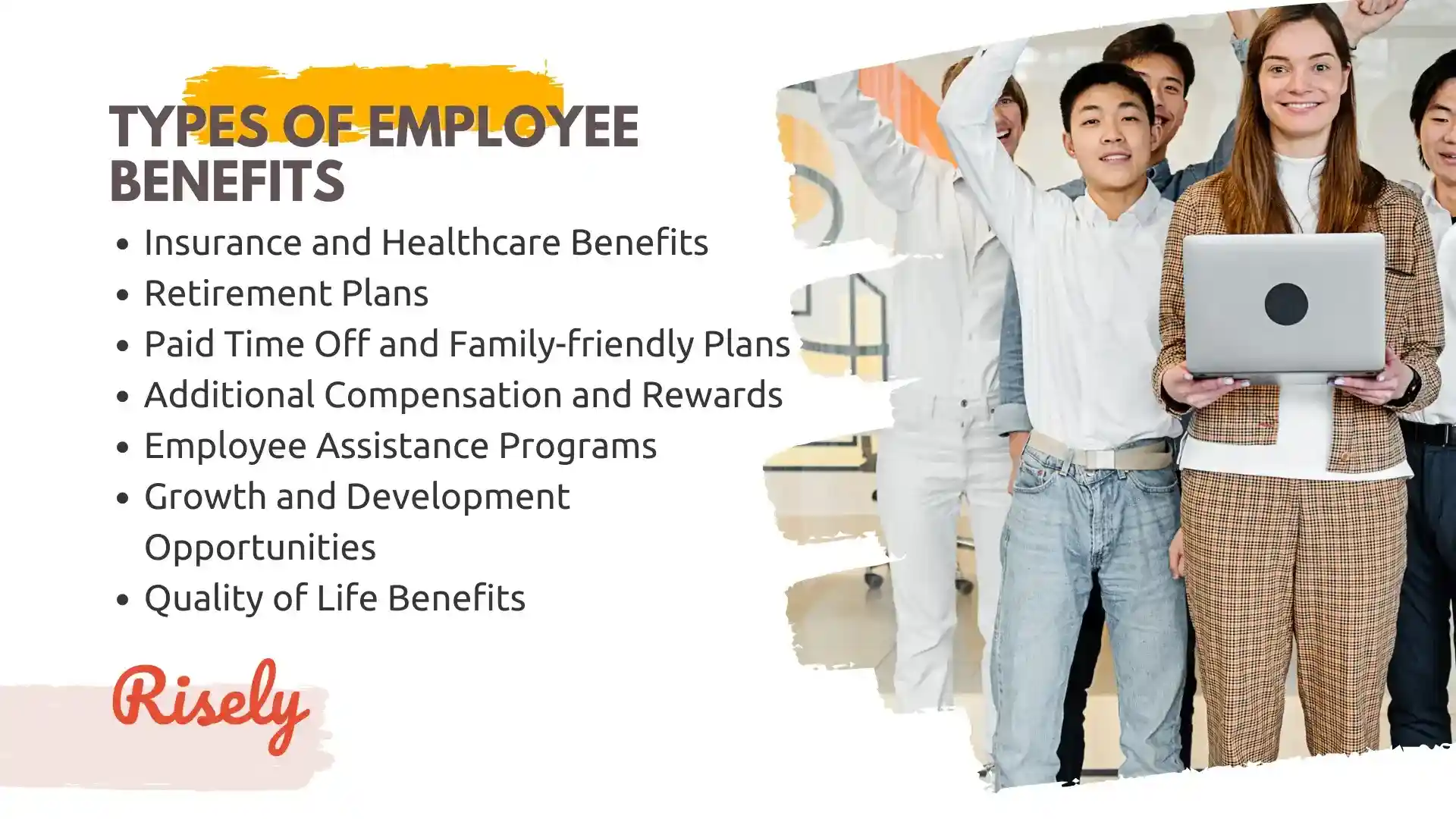
Leveraging Employee Benefits for Organizational Success
Recruitment and Retention
An attractive benefits package is a powerful tool for attracting and retaining top talent. Offering health insurance and retirement plans demonstrates a commitment to employee well-being and financial security. Generous paid time off policies incentivize loyalty and support work-life balance. Fringe benefits like parental leave are vital in maintaining a diverse workforce. Additionally, employee perks contribute to increased job satisfaction and reduced turnover. Organizations can effectively recruit and retain their employees by providing an enticing range of benefits creating a positive and supportive work environment.Employee Satisfaction and Productivity
A great employee benefits package paves the road to employee satisfaction and productivity. Hence, ensuring that the needs of employees are taken care of and that they are supported to live a fulfilling life is the secret to having a more effective and productive workforce. Without such practices, employees are bound to be stressed and look for other income streams, leading to poor quality work and a disgruntled environment.Branding and Reputation
A strong employee benefits program enhances a company’s branding and reputation. Employees’ positive experiences with their benefits also translate into positive customer experiences. Employee testimonials highlighting the benefits they receive can also attract potential customers, showcasing the company’s commitment to employee well-being. Moreover, a reputation for caring about employees’ well-being attracts top talent, as job seekers value organizations prioritizing their employees’ needs. Social responsibility initiatives through benefits further improve the brand image, showcasing the company’s commitment to positively impacting society.How to Create an Effective Employee Benefits Plan?
Getting Started with Employee Benefits
An essential set of actions that any HR manager needs to take before initiating employee benefits include:- Building a benefits team: Collect a group of informed and skilled individuals to lead and formalize the entire benefit administration process. Ideally, The group should have expertise in employee relations, managing motivation, financial limits, best practices, legal compliance, and administrative capabilities.
- Preparing policy documents: Establish clear and documented policies and procedures outlining how benefits are administered, including eligibility criteria, enrollment processes, and changes to benefits. It should also contain details about claims and reimbursement handling.
- Set up software and dashboards: Employee benefits administration software can help HR managers keep track of the various elements, including the provision of benefits, participation and success rates, and feedback. Setting up employee dashboards allows employees to access relevant details and plans anytime.
- Thinking of Grievances: As time passes, grievances are set to arise. Hence, it’s best to prepare for them at the outset. Enforce a system of checks and balances to ensure compliance with rules and norms. Create an approachable process for employees to share their concerns and problems with the benefits scheme.
Assessing Employee Needs
Building a practical benefits plan begins with data. Although not all features can be accurately reflected, it provides the ground to get started. Considering employees’ demographics and life stages, design a benefits plan that caters to their specific requirements. Analyze feedback and preferences related to healthcare, retirement, and other employee benefits. Feedback forms and employee benefits surveys can help you in this stage, along with observation of performance. Evaluating the cost-effectiveness of different benefit options is crucial to ensure the plan aligns with current market trends and industry standards. This assessment process helps create a well-rounded benefits plan that addresses employee needs and enhances overall satisfaction.Set Objectives and Define Metrics for Your Team
In the next step, you need to identify the strategic goals for your team that will also guide your benefits strategy. Your team’s values are also an important consideration here. Creating a balance that enables the expression of both is the key. For instance, if your team wants to build high-performers, you can add incentives based on performance metrics. On the other hand, if you focus on employee well-being, access to wellness programs at subsidized rates would find a place in your benefits package. The key is to answer central questions about your benefits strategy:- What do you want to achieve through your employee benefits plan?
- What are your team’s core values that this plan should reflect?
- At what pace can you focus on these goals, given the current financial and operational constraints?
Get Legal and Financial Sides in the Loop
Effective resource allocation is necessary for an employee benefits program to succeed. At this stage, focus on the available budget for your employee benefits program. It should include the direct cost of financial benefits and incentives, non-financial incentives, and administrative costs. Finding suitable options from aggregators for services like insurance, wellness programs, and other partners is vital to balance the employee’s needs and your expenses. Simultaneously, legal considerations in employee benefits should not be missed. Staying current on the local laws about benefits is essential to ensure compliance. In addition, many regulations call for specific benefits for some classes of individuals that need to be kept in mind while planning.Build the Benefits Package and Options
Based on the terms identified in the process thus far, including the employees’ needs and preferences, the team’s vision, and the financial and legal guidelines, choose elements that best satisfy your goals. The employee benefits package needs to fulfill the needs of various people, making flexibility and availability of options a critical condition. You can also make some benefits voluntary to enable employee participation in the process.Setting and Communicating the Processes
The role of HR managers is critical at this stage as they need to ensure that the employees are not only aware of the benefits but also able to access them easily. Developing a comprehensive communication strategy that includes standard guidelines and details about the benefits is essential. It should ideally cover the benefits’ scope, accessibility, and eligibility conditions (if any). In addition, such documents should be regularly updated to help employees and made available across the teams.Continuous Monitoring and Assistance
Before closing the process, HR managers need to ensure that the benefits are working out as planned. It includes monitoring their usage, the impact created, and keeping feedback from the users. Some elements of benefit programs, such as wellness sessions and e-learning platforms, would also need regular upkeep and updates. Moreover, some employees may need assistance to thoroughly evaluate and enable benefits for themselves, which the HR managers can provide.Regular Review and Update of the Plan
Regularly reviewing and updating the employee benefits plan is crucial to ensure it remains relevant and effective in meeting the evolving needs of employees. Staying informed about changes in laws and regulations that impact benefit offerings is essential to avoid legal complications. Seeking employee feedback on their satisfaction and suggestions for improvement helps create a plan that caters to their preferences. Benchmarking against industry competitors allows organizations to stay competitive and offer attractive benefit packages to the needs of the current and upcoming workforce.Addressing Employee Benefits Misconceptions and Challenges
To address misconceptions about employee benefits, consider implementing educational workshops that clarify the different types of benefits available. It can help employees better understand their options and make informed decisions. Additionally, offering personalized guidance can further assist employees in navigating the complexities of benefit plans and addressing any concerns, especially when onboarding new employees. By clearly communicating certain benefits’ value and long-term financial impact, you can help employees see the positive impact these offerings can have on their overall well-being. Resources and tools like online portals or interactive guides can empower employees to make informed benefit decisions.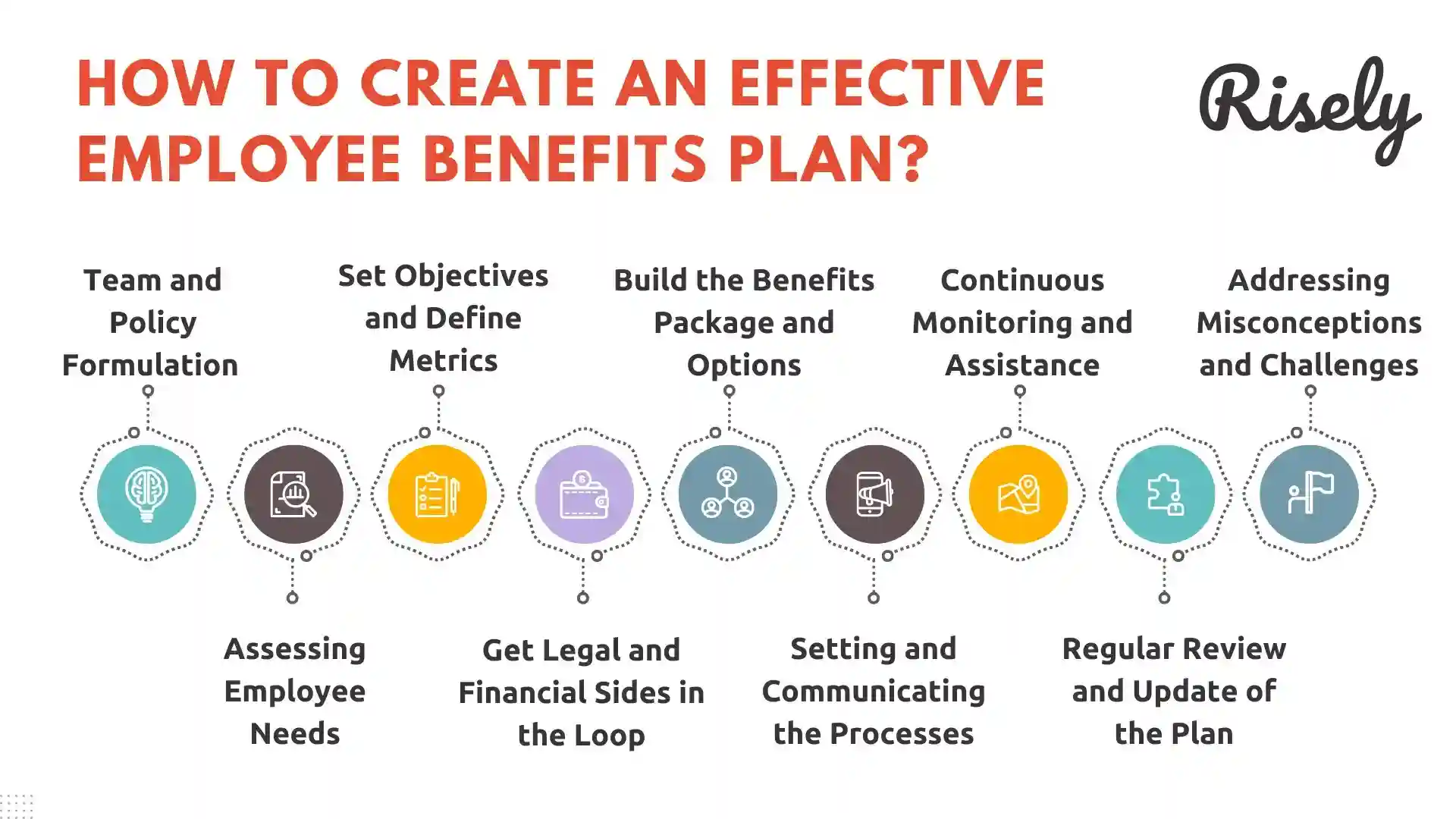
Calculating the Cost of Employee Benefits
The financial constraints of the team invariably impact every employee benefits program. Hence, calculating the cost of benefits is essential to creating a strategy that works for your team. The major areas that you should include in making this calculation are:- Direct financial benefits
- Contribution to insurance and retirement funds
- Paid time off
- Cost of wellness programs
- Expenses related to coaches, mentors, and other service providers
- Cost of reimbursed expenses like gym memberships, food, discount coupons, tuition support, etc
- Platform fees for the tools used
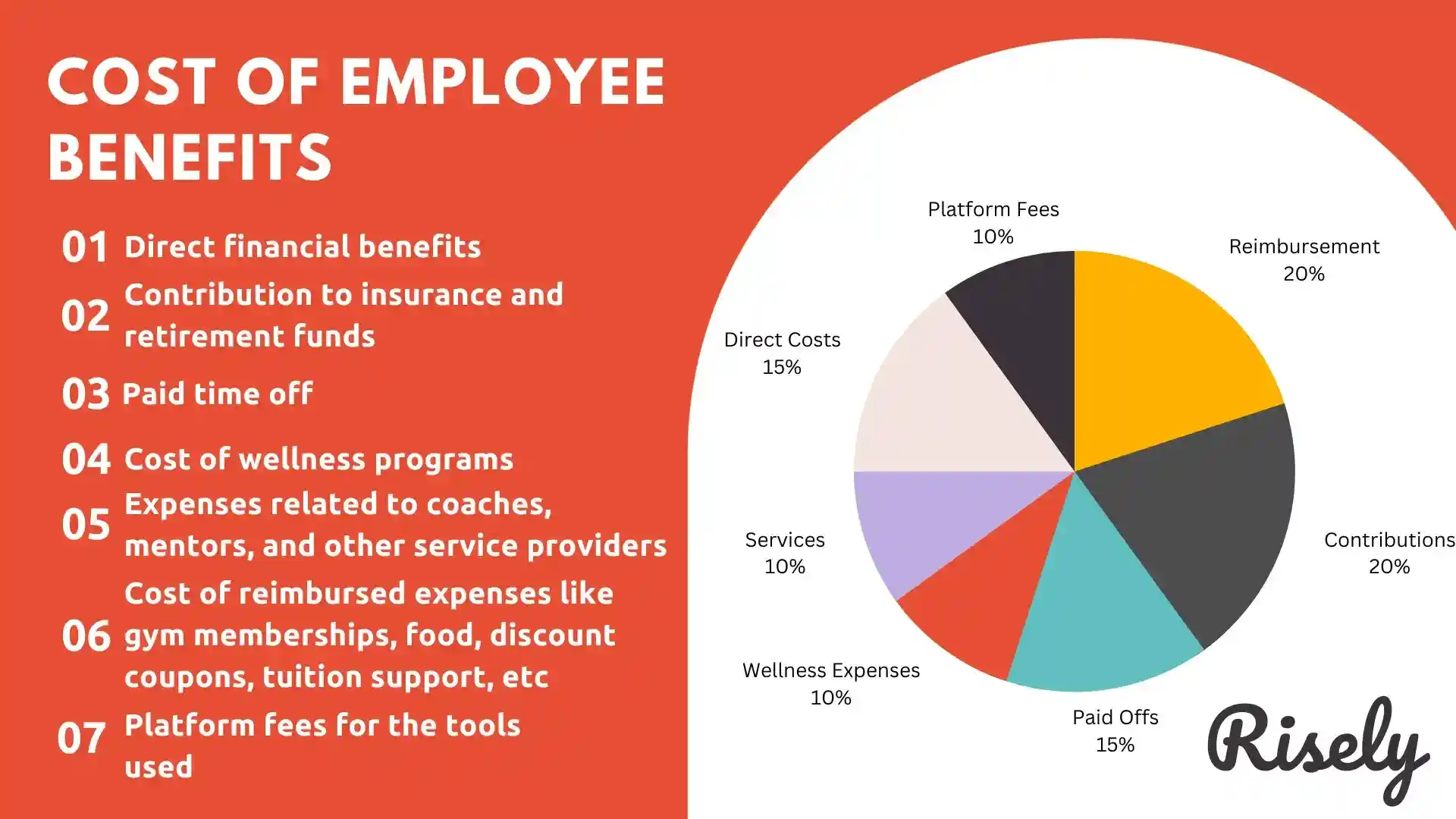
- Employee co-pay options: Enable employees to share a part of the cost for certain benefits while the employer contributes the remainder. It is most typically done for insurance and retirement plans.
- Partnerships with organizations: Partner with training and wellness service providers to enable group discounts for your team.
- Voluntary contributions: Allow employees to contribute to shared benefits voluntarily. For instance, employees can add dental care to their insurance plans with some additional payments.
- Voluntary programs: Allow employees to choose the benefits that they deem valuable. For example, employees can select learning opportunities that supplement their growth instead of undergoing generic training.
- Flexible spending accounts: Encourage employees to use pre-tax dollars to cover out-of-pocket healthcare expenses by offering FSAs. Employees can contribute to these accounts through payroll deductions, reducing their taxable income and helping cover co-pays, deductibles, and other medical costs.
Conclusion
In conclusion, employee benefits are crucial in attracting and retaining top talent, boosting employee satisfaction and productivity, and enhancing an organization’s branding and reputation. When creating an effective employee benefits plan, it is essential to assess the specific needs of your employees and regularly review and update the plan to ensure its relevance and effectiveness. Additionally, addressing misconceptions and challenges surrounding employee benefits is essential, and organizations should take proactive measures to ensure that employees fully understand and appreciate the benefits they receive. Organizations can create a positive and supportive work environment that contributes to long-term success by prioritizing employee benefits.One-on-one meetings can help you understand the right benefits for your team. Ensure you’re doing them right.
Take the free effective one-on-one meetings assessments for managers now to avoid typical mistakes.
Other Related Blogs
5 Ways To Master Emotional Management At Work For Managers
5 Ways To Master Emotional Management At Work For Managers Management of emotions is one of the most crucial skills managers need to lead and manage their teams effectively. Unfortunately,…
5 Crucial Steps To Balancing Stakeholders As A Team Manager
5 Crucial Steps To Balancing Stakeholders As A Team Manager Balancing Stakeholders can be a daunting task, but it can be much easier with the right approach and strategies in…

